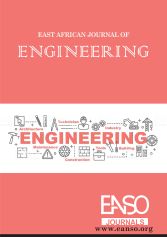Design and Construction of a Solar Powered Silver - Fish Dryer for Enhancing Food Security and Economic Livelihoods of Fishing Communities in East Africa
Abstract
The aim of this study was to design and construct a solar-powered silver-fish dryer that would help reduce the post-harvest losses experienced by fishing communities in East Africa. The system was developed with the goal of promoting food security, improving preservation methods, and enhancing the quality of dried silver-fish. The construction process involved welding, wiring, and soldering various materials, with the trays made from wood and metallic meshes measuring 37 cm by 33 cm. The fabricated cover was also made of wood and measured 47 cm by 63 cm. Three 100-watt bulbs were utilized as heaters, while a CM 3024Z charge controller was connected to a 20W solar panel to manage energy flow. The system was successfully designed and constructed as planned. The direct current (DC) supplied to the dryer was 12 volts. The temperature sensor operated at 5 volts, the heater at 120 volts, and the fan at 12 volts. The charge controller regulated the solar panel’s energy supply to the battery, and the inverter converted the direct current to alternating current (AC) to power both the fan and the heater, thereby minimizing energy losses. The dryer system ensures continuous drying, regardless of weather conditions, by efficiently harnessing solar energy to power the heating system. This results in improved cleanliness, reliability, and the ability to dry large quantities of silverfish effectively. The solar-powered silver-fish dryer designed and constructed in this study proves to be an effective solution for addressing post-harvest losses in East Africa's fishing communities. The system's integration of solar energy, combined with an efficient drying mechanism, ensures continuous operation regardless of weather conditions, thereby improving reliability and preserving the quality of the dried fish.
Downloads
References
Abdul Razak, A., Tarminzi, M. A. S. M., Azmi, M. A. A., Ming, Y. H., Akramin, M., & Mokhtar, N. (2021). Recent advances in solar drying system: A Review. International Journal of Engineering Technology and Sciences, 8(1), 1–13. https://doi.org/10.15282/ijets.8.1.2021.1001
Al Haddabi1, T., & Rajakannu, A. (2024). Design and Development of a Low-Cost Parabolic Type Solar Dryer and Its Performance Evaluation in Drying of King Fish – Case Study in Oman. https://doi.org/10.20944/preprints202409.0620.v1
Mohsin, A. S. M., Maruf, M. N. I., Sayem, A. H. M., Mojumdar, M. R. R., & Farhad, H. M. S. (2011). Prospect_and_Future_of_Solar_Dryer_Persp. IACSIT International Journal of Engineering and Technology, 3(No.2), 165–169.
Jensen, S. Ø. (2002). Solar drying in Ghana Final report.
Karim, E., Haque, M. A., Rahman, M. J., Karim, E., Uddin, M. S., Zaher, M., Haque, M. A., & Shahab Uddin, M. (1998). Development Of Low-Cost Emergency Fish Dryer In Bangladesh To Use In Absence Of Sunlight (Issue 7). http://www.bdresearchpublications.com/admin/journal/upload/09344/09344.pdf
Lwenya, C. A., & Abila, R. O. (2004). The role of women in artisanal fish processing and trading on Lake Victoria (Kenya. African Journal of Tropical Hydrobiology and Fisheries, 10(1). https://doi.org/10.4314/ajthf.v10i1.1400
Ndirangu, S. N., Erick, E., Ronoh, K., Kanali, C., Mutwiwa, U. N., Ndirangu, S. N., Ronoh, E. K., Kanali, C. L., Mutwiwa, U. N., & Kituu, G. M. (2020). Design and performance evaluation of a solar-biomass greenhouse dryer for drying of selected crops in western Kenya. http://www.cigrjournal.org
Omagor, I., Kigozi, J., Muyanja, C., Muzira Mukisa, I., Mukisa, I., Namwanje, M., & Chimatiro, S. K. (2020). Artisanal processing and preservation practices carried out by silver cyprinid (Rastrineobola argentea) processors along the shores of Lake Victoria in Uganda International Journal of Fisheries and Aquatic Studies 2020; 8(4): 265-273 Artisanal processing and preservation practices carried out by silver cyprinid (Rastrineobola argentea) processors along the shores of Lake Victoria in Uganda. http://www.fisheriesjournal.com
Omojowo, F. (2009). Adaptation and Improvement of a Simple Solar Tent Dryer to Enhance Fish Drying. http://www.sciencepub.net
Oparaku, N. F., Mgbenka, B. O., & Eyo, J. (2010). Proximate and organoleptic characteristics of sun and solar dried fish. www.zoo-unn.org
Rana, M. S., Rahman, A. N. M. A., Ahmed, R., Hossain, M. P., Shadman, M. S., Majumdar, P. K., Islam, K. S., & Colton, J. (2024). Design, Fabrication, and Performance Evaluation of a Food Solar Dryer. AgriEngineering, 6(4), 4506–4523. https://doi.org/10.3390/agriengineering6040257
Reza, Md. S., & Hossain, Md. A. (2024). Development and performance assessment of a hybrid solar cabinet dryer for fish drying. Energy and Thermofluids Engineering, 3, 29–38. https://doi.org/10.38208/ete.v3.758
Sifuna, A., Onyango, D., Akinyi Owigar, R., O Kowenje, C. B., M, O. D., W, S. A., Hbo, ayia, & O, O. A. (2017). Evaluation of Fish Processing and Preservation Systems along the Shores of Lake Victoria towards Enhancement of Sun Drying Technology. International Journal of Food Science and Nutrition Engineering, 2017(5), 111–118. https://doi.org/10.5923/j.food.20170705.02
Tyona, & Ojiya, E. D. (2024). 56| Design, Fabrication and Characterization of a Solar Fish Dryer Design, Fabrication and Characterization of a Solar Fish Dryer.
Velukumar, E. V, Rajalakshmi, G., Baranitharan, S., & Sathiswaran, T. (2024). Automated Temperature Controlled Solar Dryer for Ascorbic Acid Retention in Fruits. In International Journal of Environmental & Agriculture Research (IJOEAR) ISSN (Vol. 10, Issue 6).
Whiston, A., Rost, A. W., Mangeni, R. S., Bruce, C., & Brierley, A. S. (2022). Drying fish (Rastrineobola argentea) on the bank of Lake Victoria in a prototype solar-heated enclosure: Using renewable energy to reduce drying-time and improve product quality and value. African Journal of Food Science, 16(11), 289–300. https://doi.org/10.5897/ajfs2022.2195
Copyright (c) 2025 Sollomy Ainomujuni, Andrew Tinkasimire

This work is licensed under a Creative Commons Attribution 4.0 International License.




























